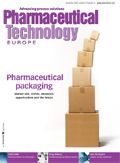Simplifying data management
Pharmaceutical Technology Europe
Paper is no longer a sufficient format for information storage and interchange in the pharmaceutical industry; documents are inflexible and costly for production and storage.
Paper is no longer a sufficient format for information storage and interchange in the pharmaceutical industry; documents are inflexible and costly for production and storage. Several electronic formats can be used to automate information and data management, but Sebastian Goettel, Director of Sales at SCHEMA (Germany), believes XML to be the solution of choice because it is extremely versatile — it can handle a wide range of structured and semistructured information. It also offers valuable features such as full text searching.
"XML is a well-suited technology to automate document creation and maintenance because it makes the content of documents fully accessible to software applications and an initial print document can be automatically adapted for an online portal," said Goettel. "And it's not only formatting for different media channels that can be automated; XML also makes it possible to autonomously validate business rules on document content. In addition, XML can be used to mix information sources to generate new documents automatically."
Goettel accepts that there are other formats available where certain types of information may "be even better exchanged than using XML"; however, he emphasized that for text "there is no better solution". "When it comes to textual information, XML offers the advantage of the strict distinction between content and layout," he explained.
Even though other formats, such as PDF or TIFF files, can be used, XML offers clear advantages for the pharma industry because of recent changes in information submission to regulators. The EMEA, for example, currently encourages the use of electronic submissions for marketing authorizations via the Electronic Common Technical Document (e-CTD), which uses XML as its backbone. This format will become mandatory in January 2010. Meanwhile in the US, the FDA already mandates the use of e-CTDs for marketing authorization submissions.
These regulations can only have a positive effect on the pharma industry. According to Goettel, "Document creation and maintenance processes can potentially offer dramatic increases in productivity. The pharma industry should take the opportunity to modernize its processes, even beyond regulatory standards."
The uptake of XML in the EU has also been boosted by the EMEA's Product Information Management (PIM) initiative, which enables companies to submit product information in XML format to the agency. Although the initiative is only in a pilot phase at present, the EMEA recently issued a statement of intent declaring that it intends to fully implement the initiative into the centralized procedure within 2 years. "Now that the PIM initiative has received a boost, a lot of labelling departments have no choice but to implement an XML solution," said Goettel. "However, PIM is only a part of the requirements for document creation and maintenance processes in labelling departments. I sincerely hope that in the future we will see solutions that cover all areas of activity."
So it is clear that an XML-based system will feature prominently in pharma companies' data management departments, but will implementation be a simple process? According to Goettel, XML is already widely used in the pharma industry and there is also a wide range of available tools and books that can aid implementation. However, he also offers a word of caution: "These often focus on technical details such as document type definition creation or stylesheet programming, but this accounts for less than 10% of successful implementation. User acceptance, suitable workflows improving business processes and a powerful content management system are the key factors for success."

Drug Solutions Podcast: A Closer Look at mRNA in Oncology and Vaccines
April 30th 2024In this episode fo the Drug Solutions Podcast, etherna’s vice-president of Technology and Innovation, Stefaan De Koker, discusses the merits and challenges of using mRNA as the foundation for therapeutics in oncology as well as for vaccines.